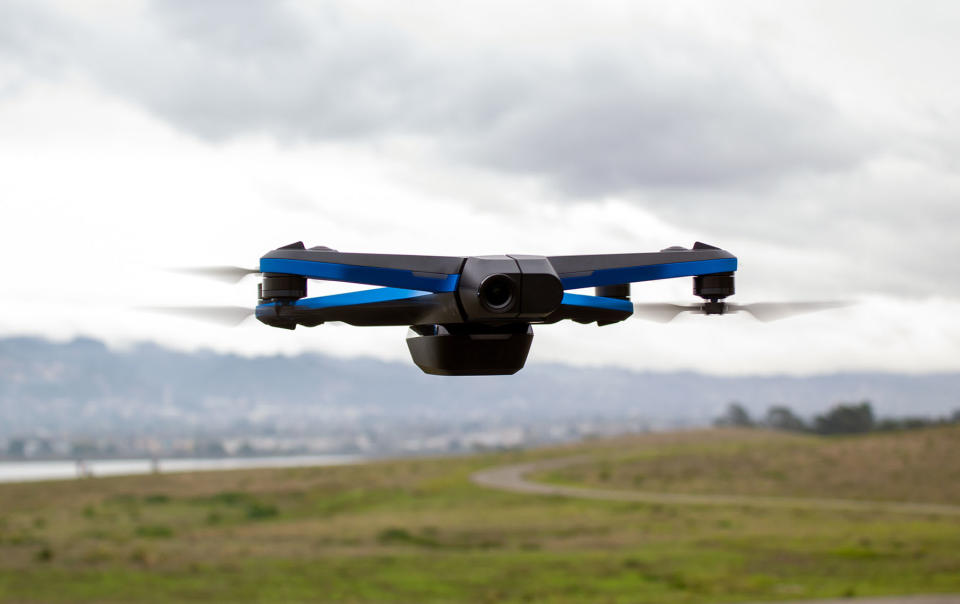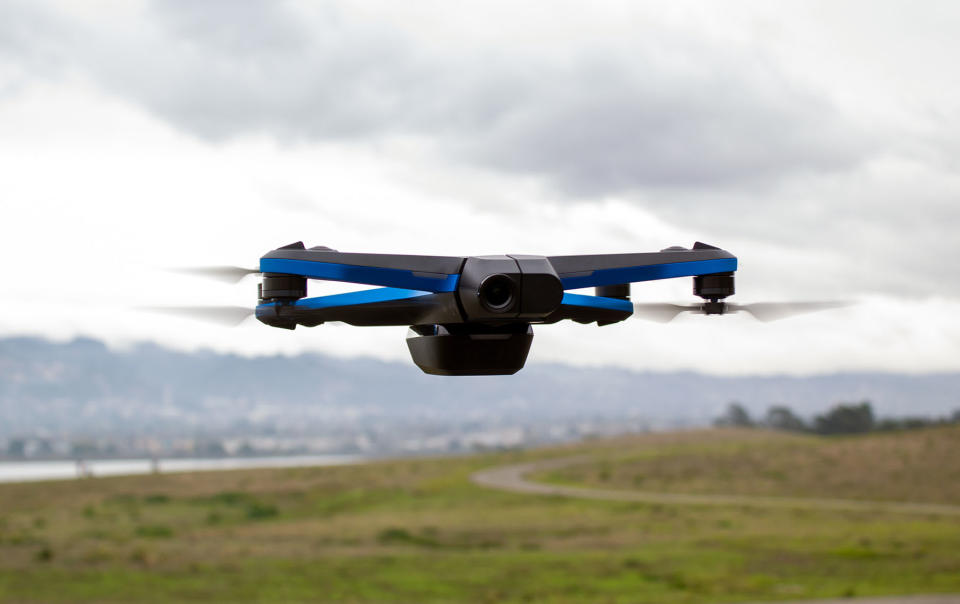Skydio 2 review: The best self-flying drone is now a great all-rounder
But there's still room for improvement.
Around a year and a half ago, Skydio blew my mind. The then-unknown company presented the R1 drone to the world, and it was quite special. Typically, follow features and obstacle avoidance aren't very effective, or only work in certain modes (i.e. with compromises). Skydio's R1 put these features front and center, and it did them incredibly well. But there were still caveats. The R1 was prohibitively expensive ($2,499 at launch), large, clunky and limited in what it could do beyond all that following and obstacle avoiding.
Enter the Skydio 2, the company's second take on a drone. It's cheaper, smaller and much more versatile. The hope is that it will be the much-needed DJI rival we deserve, and I'm excited about it enough to say right here that it is. But, and yes there are some buts, it still has some edges that need smoothing out. I'll get to those in good time, but for now, let's start with the positives.
As I mentioned in my original hands-on, at 10.7 by 8.7 by 3 inches the Skydio 2 is much smaller than the R1 (13 x 16-inches). It doesn't fold down like most DJI drones, but it's small enough to slide into any backpack, and there's a hard carry case that can easily be worn like a satchel. Portability? The Skydio 2 has it. The $999 base package includes that case, one battery and some spare propellers. The nearest DJI drone by price is the Mavic Air ($919), which also comes with a case, plus a handheld controller -- something that costs extra with the Skydio 2.
So the drone is smaller and cheaper, but that alone merely makes it a better proposition than its predecessor. If it wanted to compete with DJI, Skydio needed to add more functionality and, thankfully, it has. In spades. My biggest gripe with the R1 was that you couldn't really do anything beyond basic "follow" shots. It had rudimentary controls via the app, but sweeping landscape shots, or any sort of independent flight, was incredibly limited.
With the Skydio 2, the app controls are still sparse, but there are now two new ways to fly the drone. They'll cost you, but they're definitely worth it. To the point where I'd say buying the Skydio 2 without at least one of these accessories is doing yourself a massive disservice. One is a wand called the "Beacon" and the other is a conventional two-stick controller. Both cost $149 and both have their own strengths, which one is right for you will depend on your goals.
The core use-case of the drone (to follow and safely avoid obstacles) has also been upgraded. The R1 used an array of cameras to "see" in 3D (and 360-degrees), all in real-time. It worked really well, but Skydio still saw fit to improve it. With the Skydio 2, the cameras dotted around the drone are much higher resolution, meaning it can see in more detail, and theoretically, avoid more things with more precision.
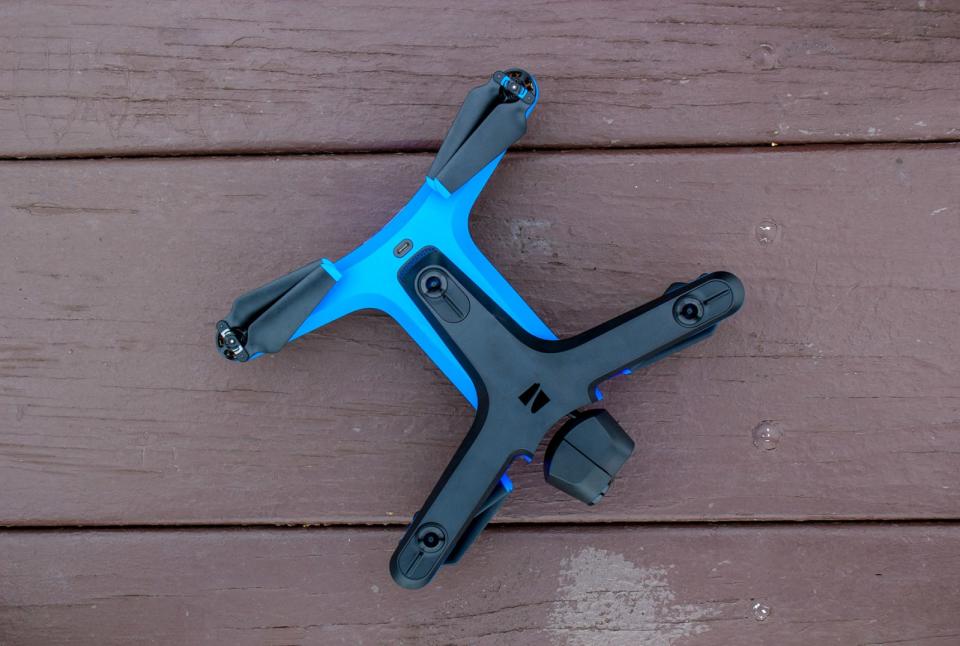
Testing this is kinda hard. If only because the R1 already tackled everything I threw at it. And pushing the Skydio 2 to dangerous limits (flying at telegraph cables and so on) is not something you should ever, ever do intentionally. All this to say, the Skydio 2 still has supreme obstacle avoidance skills. It's when you use them in conjunction with one of the new controllers, though, that they become most exciting.
One thing that hasn't been upgraded is how easy the drone is to use. Mostly, because I'm not sure it could get any easier. Batteries connect magnetically, with a satisfying "thunk" and pairing with the app is seamless, something even DJI can't seem to manage. And your first flight will be effortless -- simply hold the "launch" button in the app on your phone and select the person you want it to follow (so make sure the drone is pointing in your/their general direction when you set it down).
Once it's up in the air and tracking, more on-screen controls let you adjust the drone's height, distance from its target and rotation. There is the usual selection of "auto shots" -- pre-defined movements like "orbit" and "dronie" (the awful portmanteau of selfie and drone no one asked for). There's also a rudimentary virtual joystick to "fly" the Skydio manually. As much as it works, you won't want to rely on it for more than the most basic of maneuvers.
A feature that's not new to the Skydio 2, but was launched after I reviewed the R1, is the ability to follow cars as well as humans. I tested this while on a road trip, off the beaten path, and I'm happy to report it works just as well as tracking a human. The Skydio 2 has a top speed of 36 mph, much faster than the R1 (25mph). While this means you won't be able to film yourself driving down the freeway (please don't ever try), it can certainly keep up with backcountry rides -- even when in orbit mode when it has to "overtake" the car on each rotation. The resulting footage looks great, too -- like something from a car commercial. I am not sure how much of it you'd want to use in a final video, but it's a nice option nonetheless.

Where the Skydio 2 really comes into its own, at least, compared to the R1, are those aforementioned controllers. I'll start with the "regular" controller, as that's the one I feel is most useful and exactly what the R1 was lacking. At $149, it's not an impulse purchase, but it's one that I would truly recommend.
Why? Because it exponentially expands the usefulness of the drone. You can control the Skydio 2 just fine with your phone for those tracking shots, and even carve out some basic establishing shots or wide angles, if you so choose. But with the official controller, the Skydio 2 breaks out of those chains and becomes a fully-fledged camera drone. But, and here's the kicker, you get all that smart AI obstacle avoidance thrown in to boot.
When I first flew the Skydio 2 with the controller, I did so in an open space. I wanted to get a feel for how it behaves in the air, the range and so on. But once I had a handle on things, I started testing the obstacle avoidance. First, by trying to fly into a small tree -- it moved right round it. I gently upped the ante with other inanimate objects until I was more confident.
Before long, I really had a sense that this thing would dependably not crash into things, and this gave me the confidence to fly where otherwise I might not. Not because they were unsafe places to fly (again, please never do that), but because they're hard to reach or difficult to judge distance. Large objects in the distance often appear nearer. If you've ever tried to fly a drone out to something over, say, 500 feet away, you'll know that it usually takes longer than you thought (if judging the distance by eye). Imagine then, trying to maneuver around something that far away, especially if it has a complex surface or structure.

Example: On my road trip, I went to Bryce canyon. That's a national park where flying is not permitted. But a few miles out of the protected zone, there are still some interesting rock formations. Once I found one where it was safe and flying was permitted, I took the Skydio 2 up and headed toward a rock formation with a protruding column. It was high enough that I couldn't see what was behind or beneath it. With a regular drone, I'd worry I might hit something, or just misjudge the distance altogether. With the Skydio 2, I felt comfortable that if I came in too low, it'd pull up, or if I was too close, it would move aside. Both these things happened, and the drone effortlessly corrected itself out of the way.
Once I had flown around the back of the column, I could see on the video feed that there was a treetop right behind it. If I had been flying any other drone I might well have clipped the top of that tree. DJI's obstacle avoidance is functional, but I never rely on it, it's more there as "insurance."
Boosted by this flight, I tried something else -- flying among the trees below the rocks. Here, I was able to push it even further, flying within inches of the trees, spinning around and carving patterns between them that would otherwise be beyond my skills. The result was footage I would never normally be able to confidently capture -- close proximity to objects, often at speed. This, to me, makes the Skydio 2 incredibly appealing. It doesn't make a bad pilot good, but it can make a competent pilot better, resulting in much more dynamic video, and after all, that's what the Skydio 2 is all about.
The "Beacon" controller is less capable, but still interesting -- and will appeal more to those who want to focus on follow footage, but with more control. The Beacon is about the size of a small TV remote and expands on the rudimentary controls within the app with tactile buttons and, more interestingly, gesture controls. In short, hold down a button, wave the Beacon around, and the drone will follow.
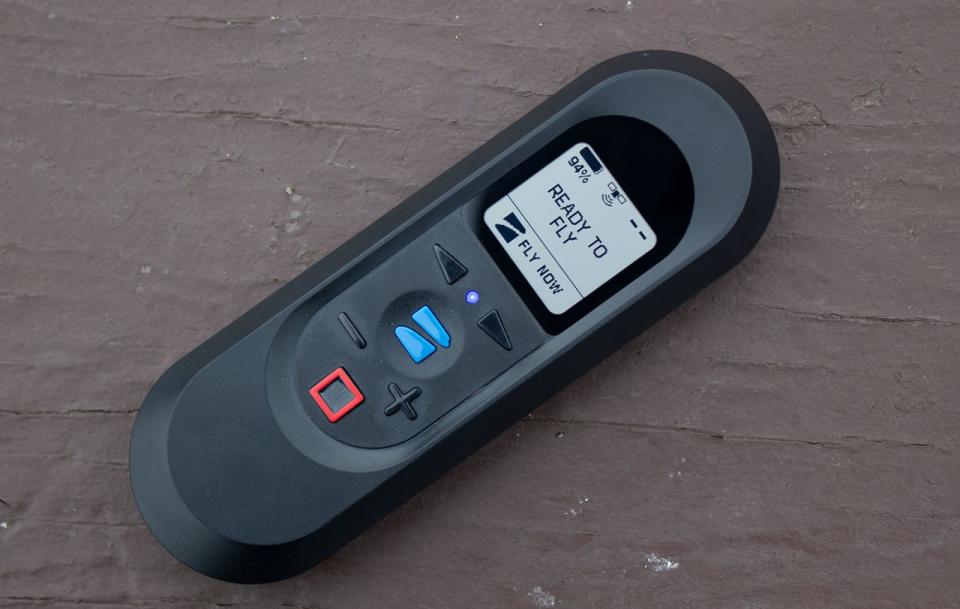
Want to move the Skydio 2 around in front of you? Simply "drag" it there with the Beacon. You can also adjust height, distance, fly modes and more. As a bonus, the Beacon has GPS in it, which bolsters the Skydio 2's tracking capabilities. For example, if you're cycling and some trees block the drone's view of you, it'll still track your location based on GPS. It's fun, useful and also another $149 extra. But likely worth it if it fits your use case.
Now might be a good time to talk about the actual camera. As before, it shoots 4K video and 12-megapixel stills. Skydio tells me that, this time, it built its own camera from the ground up. Compared to the shooter on the Mavic 2 Pros, the manual exposure options are slightly limited. You can tweak white balance, shutter speed and ISO and there's exposure compensation too -- but this is enough for most people. You can also choose image mode (JPG/RAW) and set it to shoot in intervals. Personally, I preferred to pull stills from the video -- something you can easily do in the app. It might not be a dedicated photo, but the quality was good enough for my needs.
One slight bummer is the lack of internal storage this time around. The R1 had a generous 64GB built-in, meaning you didn't need a memory card. It made exporting videos a bit more convoluted, but it was a nice feature. I'd have liked to see maybe less storage, 16GB or so, with the option to expand via an SD card (it's handy for those days you forget your memory card if nothing else), but alas it wasn't to be. Now that it's memory card only, at least exporting your video is a lot more straightforward. Another benefit is that the camera's placed right up front, with nothing above it (unlike most DJI's) which means the camera can also point upwards, handy for when you fly a little too low and want to quickly reframe.
Overall, the image quality of the Skydio 2 is solid. I didn't notice any artifacts and performance was acceptable in lower light (or cloudy) conditions. I involuntarily tested this extensively, as the weather was overcast for the majority of my time with the drone. I did notice that the sky was sometimes blown out when the sun was behind light clouds (you can see this near the start of the video above). It soon rectified itself once the image had less competing light conditions (dark shadows and light sky etc). In better lighting, it obviously performed much better, which you can see towards the end of the sample footage.
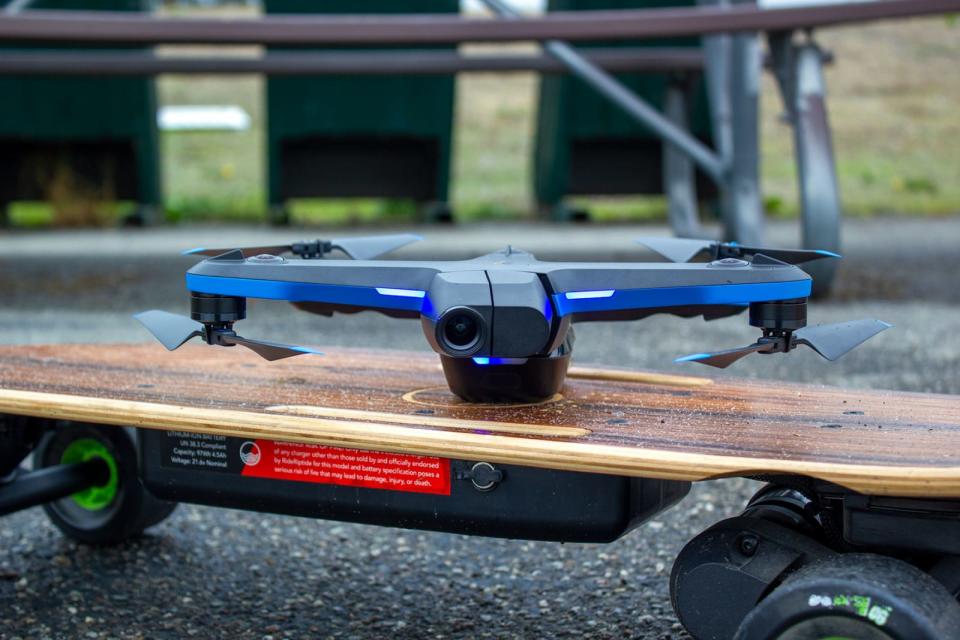
The Skydio 2's sensor is 1/2.3 inches, which puts it in the same category as the Mavic Air, rather than the Mavic 2 Pros (which sport 1-inch sensors), but for most situations with normal lighting conditions, the Skydio 2 delivers great results.
There are a couple of areas that the Skydio 2 could improve. The primary one is the WiFi range. When controlling the drone with just your phone, this is less of an issue, as you'll be tracking yourself, and therefore want to keep the drone fairly close. Skydio claims a range of over 600 feet under ideal conditions, but I don't imagine too many scenarios when you want to go that far out while tracking. When using the controller, though, you can (and should) take it out a little farther -- and this is where things were a little more dicey.
On at least two occasions, I had the video feed drop out because the drone was evidently too far for the connection to hold. On one of those occasions, the drone lost radio connection too, so it automatically flew "home." The distance was different on both days, and both well within Skydio's claimed range of over two miles (the controller extends the WiFi range considerably). On the flight where it flew home, I was only 1,000 feet out (about 0.2 miles), so it should have been comfortably within range.
The net result was a temporary loss of video feed (but not video recording) during one flight, and a safe, if unwanted, "return to home" of the drone in the other. Ideally, these things wouldn't happen when well within the claimed range. DJI's OcuSync video feed has a claimed range of over four miles, by comparison, so now that the Skydio 2 is hoping to compete, this is definitely an area it can make up some ground.
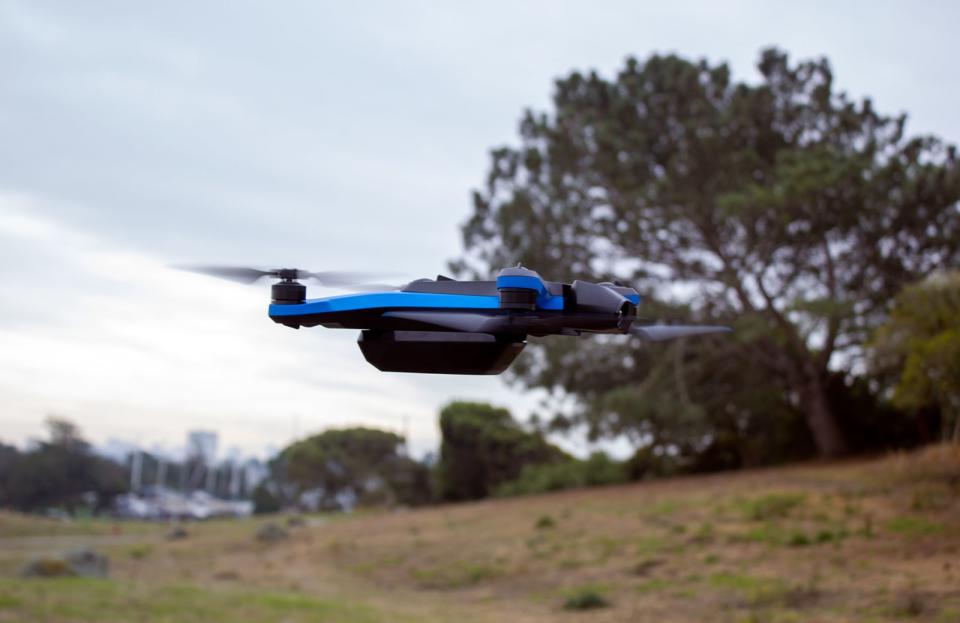
Another inconvenience is how you charge the batteries. There's no charging dock in the box, instead, you charge them while attached to the drone. This presents an obvious problem, in that you can't fly while you charge batteries. In practice, it's rare that you'd have enough time to charge a battery while you fly with another (flight time clocks in just over 20 minutes), but I would prefer the flexibility to charge cells without taking the drone out of action. There is a solution to this, but it's another optional extra -- a $129 dual charger accessory.
All in all, the Skydio 2 is a vast improvement on the R1. Even without the controllers, it's smaller, lighter and better across the board. With the controller, it finally feels like a complete drone that can tackle almost anything you'd want to do. I love how easy it is to set up and get flying, and the stellar tracking and obstacle avoidance really do open up shots that, for me, would otherwise be impossible. For most people, this is a great allrounder that isn't just easy to use but gets me excited about where I can take it (literally).
If you're more concerned about the photography credentials, and less of the AI follow features, you probably want to go with whichever of the Mavics suits your budget. DJI's camera chops are fairly well established at this point and the more fine-grained image controls will please photography purists.
For me, though, and I imagine many other casual fliers that enjoy weekend jaunts in the wild. The Skydio 2 is a very compelling package, especially if you pony up for the controller (and maybe a second battery). This configuration would cost you $1,250, which is still way cheaper than a Mavic 2 Pro and it can even do plenty that the DJI flagship cannot.

